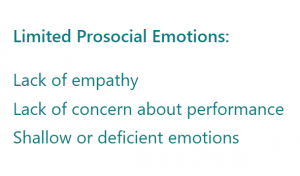Background and Further Resources

About our Team’s Research
The Developmental Risk and Resilience Unit focusses on studying the aetiology and neurocognitive processes associated with different types of conduct problems. Specifically, we have been interested in the role of callous-unemotional traits, or Limited Prosocial Emotions (LPE) in defining distinct subgroups of children with conduct problems (for a review on the importance of these traits for understanding antisocial behavior, see this article). Our work using twin study, experimental, and neuroimaging methodologies has provided converging evidence that high levels of LPE delineate a sub-group of children with conduct problems who appear distinct from their peers with low levels of LPE in aetiology and neurocognitive vulnerability.

Our research was the first to demonstrate that conduct problems and limited prosocial emotions are strongly heritable, whereas conduct problems without limited prosocial emotions are not (1,2). This does not mean that children with conduct problems and limited prosocial emotions are destined to become antisocial, but it does indicate that they have a genetic vulnerability – much like some people have a genetic vulnerability for heart disease. However, such vulnerability is not destiny. Knowing how vulnerable children develop over time, and what protective factors can influence the direction of the development, will be important if we want to help these children and their families. Such help is likely to involve behavioural interventions for the children and the families, which take into account both the specific ways in which the child sees the world around them, as well parenting and peer relationships.

We have demonstrated that those with conduct problems and limited prosocial emotions have difficulty in resonating with other people’s emotions. Although they can understand what other people think, they tend to feel less empathy for other people’s distress. By contrast children with conduct problems without limited prosocial emotions appear, if anything, over reactive to emotional stimuli and often have trouble regulating their emotions. We can also see this at the neural level. Conduct problems with limited prosocial emotions are associated with lower brain activity in emotion processing areas (e.g. amygdala) compared with typically developing children. Those who have conduct problems without limited prosocial emotions have the opposite pattern of brain activity; they look ‘overactive’ compared to typically developing children (for reviews summarising this research, please see (3,4).
Recently we have become equally interested in how children with and without conduct problems process positive affect – which provided the impetus for the development of this project. Through this research we hope to better understand why some children with conduct problems do not show the typical need to form close bonds and please other people.
Our work has highlighted that children with conduct problems are not all the same. This means that clinicians and educators may have to consider some different tactics for children with conduct problems and limited prosocial emotions, and those with conduct problems without limited prosocial emotions. As we proceed systematically with our work, we hope to gain an ever more nuanced picture of what puts children at risk and what protects them from developing antisocial behaviour. Current interventions work for many children, but hopefully, as we come to better understand the risk and resilience factors at play, we can become better still in helping the children with conduct problems and their families.
References
1 Viding, E., Blair, R. J. R., Moffitt, T. E., & Plomin, R. (2005). Evidence for substantial genetic risk for psychopathy in 7‐year‐olds. Journal of Child Psychology and Psychiatry, 46(6), 592-597. https://pubmed.ncbi.nlm.nih.gov/15877765/
2 Viding, E., Jones, A. P., Paul, J. F., Moffitt, T. E., & Plomin, R. (2008). Heritability of antisocial behaviour at 9: Do callous‐unemotional traits matter?. Developmental science, 11(1), 17-22. https://onlinelibrary.wiley.com/doi/full/10.1111/j.1467-7687.2007.00648.x?casa_token=MTC_ziZMh2QAAAAA%3AOQU-DWa3oifFKozoPN390mc02AOU6mvwnJzzsFtpYNiRBt59n3VJNAueWs3MGNsNGYdQKkpgcAEO
3 Viding, E., & McCrory, E. J. (2018). Understanding the development of psychopathy: progress and challenges. Psychological medicine, 48(4), 566-577. https://www.cambridge.org/core/journals/psychological-medicine/article/abs/understanding-the-development-of-psychopathy-progress-and-challenges/94A3478186AFE95ACD4CF89F820C0B48
4 Blair, R. J. R., Leibenluft, E., & Pine, D. S. (2014). Conduct disorder and callous–unemotional traits in youth. New England Journal of Medicine, 371(23), 2207-2216. https://www.nejm.org/doi/full/10.1056/NEJMra1315612?casa_token=Q3TREnigkDoAAAAA:HxmV83w5-pUYvRxkmHO-uLVy8p2XFum6L0smNIrsb9muULre3ZfebqOR2ZDyrbWUo-M6m_9SG-0
For summary of research published by the DRRU please refer to this web-page: https://drru-research.org/research/
